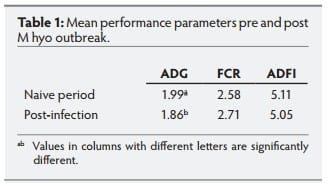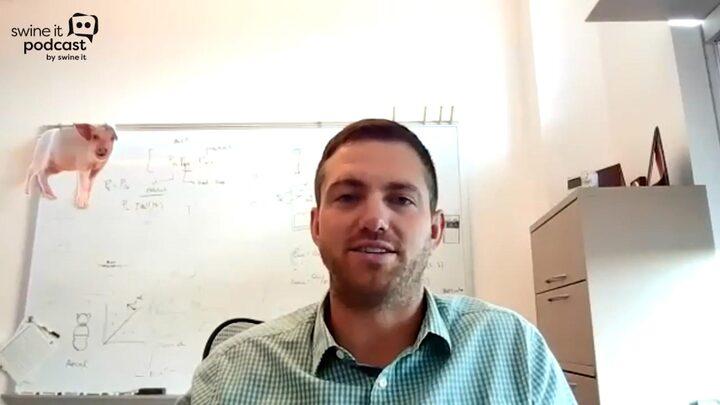Mycoplasma infection costs in a naïve swine population
Published: September 30, 2014
By: Tom Gillespie, DVM, Diplomate, ABVP (Rensselaer Swine Services, Rensselaer, Indiana)
Introduction
Mycoplasma hyopneumoniae (M hyo) remains a ubiquitous pathogen in the worldwide swine population; especially in countries with a major swine industry.1 This paper estimates the economic effects of reduced performance due to M hyo infection in a naïve commercial grow/finish flow in the United States.
Mycoplasma hyopneumoniae (M hyo) remains a ubiquitous pathogen in the worldwide swine population; especially in countries with a major swine industry.1 This paper estimates the economic effects of reduced performance due to M hyo infection in a naïve commercial grow/finish flow in the United States.
Materials and methods
A 2200 sow, M hyo naïve farrow to finish operation located in the eastern corn belt of the United States was diagnosed with M hyo in March 2010. Individual PCR’s performed on the nasal swabs for Mycoplasma hyopneumoniae; PRRSV and SIV were used to determine positive results for M hyo and negative results for SIV and PRRS virus.
Production records were evaluated comparing performance prior to and after the M hyo break. Parameters included average daily gain (ADG) and feed efficiency (FE), and the economic value for extra days on feed (overhead cost).
Economic analysis was made with the following evaluation assumptions: average feed cost of USD $239.42/ MT; average market animal revenue of USD $130.00; overhead cost of days on feed of USD $0.10 per day and a maintenance cost for feed due to more days on feed of USD $2.49 kg per day. The average initial weight at placement was 22.7 kg and average market weight was 115.7 kg. For the three parameters measured, the data were normally distributed. Student’s T-test was used for the analysis and results considered significant if P = 0.05.
A 2200 sow, M hyo naïve farrow to finish operation located in the eastern corn belt of the United States was diagnosed with M hyo in March 2010. Individual PCR’s performed on the nasal swabs for Mycoplasma hyopneumoniae; PRRSV and SIV were used to determine positive results for M hyo and negative results for SIV and PRRS virus.
Production records were evaluated comparing performance prior to and after the M hyo break. Parameters included average daily gain (ADG) and feed efficiency (FE), and the economic value for extra days on feed (overhead cost).
Economic analysis was made with the following evaluation assumptions: average feed cost of USD $239.42/ MT; average market animal revenue of USD $130.00; overhead cost of days on feed of USD $0.10 per day and a maintenance cost for feed due to more days on feed of USD $2.49 kg per day. The average initial weight at placement was 22.7 kg and average market weight was 115.7 kg. For the three parameters measured, the data were normally distributed. Student’s T-test was used for the analysis and results considered significant if P = 0.05.
Results
The M hyo outbreak significantly impacted ADG (P = 0.021). Average daily feed intake (P = 0.74) and FE (P = 0.07) was not numerically improved, but failed to reach significance based on the a set. (Table 1).
The economic analysis revealed a combined loss of USD$7.92 per market animal in the outbreak phase. The majority of the cost impact was due to slower gains (7.2 days longer to market weight). Treatment costs, mortality rate and culls were not included in this study.
The M hyo outbreak significantly impacted ADG (P = 0.021). Average daily feed intake (P = 0.74) and FE (P = 0.07) was not numerically improved, but failed to reach significance based on the a set. (Table 1).
The economic analysis revealed a combined loss of USD$7.92 per market animal in the outbreak phase. The majority of the cost impact was due to slower gains (7.2 days longer to market weight). Treatment costs, mortality rate and culls were not included in this study.

Conclusions and discussion
M hyo and the pneumonia associated with an infection remains a concern to the swine industry throughout the world. The clinical signs associated with a naïve population infected with M hyo are expressed as a respiratory challenge. The clinical signs include but are not limited to coughing, gaunt appearance, fever, labored breathing and an increase in mortality if timely treatments are not preformed.1,2 Co-infections with other primary and secondary pathogens will complicate the diagnosis and increase costs associated with treatments.
M hyo and the pneumonia associated with an infection remains a concern to the swine industry throughout the world. The clinical signs associated with a naïve population infected with M hyo are expressed as a respiratory challenge. The clinical signs include but are not limited to coughing, gaunt appearance, fever, labored breathing and an increase in mortality if timely treatments are not preformed.1,2 Co-infections with other primary and secondary pathogens will complicate the diagnosis and increase costs associated with treatments.
In this M hyo and PRRS virus naïve production system, an acute outbreak occurred in March 2010 and was clinically expressed as respiratory disease in the finishing age animals with reduced growth performance. Even though antibiotic therapies (using both individual animal and mass treatments) were utilized to control mortality and reduced under-valued animals at market time there still was a significant decrease in growth. This paper illustrates what a worldwide distributed pathogen costs when an infection occurs in a naïve swine population. Biosecurity programs can use this economic data to show why the effort is needed to limit entry of a major pathogen like M hyo. Calculations of how costs were evaluated will be discussed and illustrated during the presentation.
References
1. Thacker, EL. Mycoplasmal Diseases. In: Straw, BE, Zimmerman JJ, D’Allaire, S, Taylor, DJ. Diseases of Swine. 9th ed. Ames, Iowa: Iowa State University Press; 2006:701–717.
2. Desrosiers, R.: 2001, Journal of Swine Health Production.2001; 9(5): 233–237.
1. Thacker, EL. Mycoplasmal Diseases. In: Straw, BE, Zimmerman JJ, D’Allaire, S, Taylor, DJ. Diseases of Swine. 9th ed. Ames, Iowa: Iowa State University Press; 2006:701–717.
2. Desrosiers, R.: 2001, Journal of Swine Health Production.2001; 9(5): 233–237.
Related topics
Authors:
Join to be able to comment.
Once you join Engormix, you will be able to participate in all content and forums.
* Required information
Would you like to discuss another topic? Create a new post to engage with experts in the community.
Create a post





